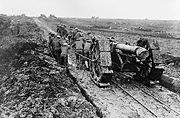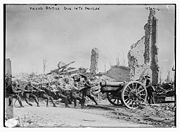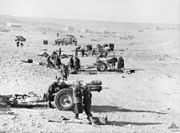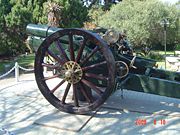
6 inch 26cwt howitzer
Encyclopedia
The Ordnance BL 6 inch 26cwt howitzer was a British
howitzer
used during World War I
and World War II
. The qualifier "26cwt" refers to the weight of the barrel and breech together which weighed 26 long hundredweights (1.3 t).


 It was developed to replace the obsolescent 6 inch 25 cwt and 6 inch 30 cwt
It was developed to replace the obsolescent 6 inch 25 cwt and 6 inch 30 cwt
howitzers which were outclassed by German artillery such as the 15 cm schwere Feldhaubitze 13
. Design began in January 1915, the first proof-firing occurred on 30 July 1915 and it entered service in late 1915. Its combination of firepower, range and mobility (for its day) made it one of the British Empire's most important weapons in World War I.
It was originally towed by horses but from 1916 onwards was commonly towed by the "FWD" 4 wheel drive 3 ton lorry as heavy field artillery. The wooden spoked wheels could be fitted with "girdles" for work in mud or sand to prevent them sinking. Towards the end of the war solid rubber tyres were fitted over the iron tyres on the wheel rims, giving the rims a heavier appearance. It fired 22.4 million rounds on the Western Front
.
 During the interwar period the carriage had its wooden spoked wheels replaced with modern steel wheels and pneumatic tyres. During World War II, its use was restricted after 1942 when the replacement BL 5.5 inch Medium Gun
During the interwar period the carriage had its wooden spoked wheels replaced with modern steel wheels and pneumatic tyres. During World War II, its use was restricted after 1942 when the replacement BL 5.5 inch Medium Gun
came into use. It was however reintroduced in Burma due to a number of premature detonations in 5.5 inches (14 cm) guns. It was declared obsolete with the end of the war in 1945.
Captured examples received the designation FH-412(e) in German use.

These guns are being restored by the Gunner's Association of South Africa
United Kingdom
The United Kingdom of Great Britain and Northern IrelandIn the United Kingdom and Dependencies, other languages have been officially recognised as legitimate autochthonous languages under the European Charter for Regional or Minority Languages...
howitzer
Howitzer
A howitzer is a type of artillery piece characterized by a relatively short barrel and the use of comparatively small propellant charges to propel projectiles at relatively high trajectories, with a steep angle of descent...
used during World War I
World War I
World War I , which was predominantly called the World War or the Great War from its occurrence until 1939, and the First World War or World War I thereafter, was a major war centred in Europe that began on 28 July 1914 and lasted until 11 November 1918...
and World War II
World War II
World War II, or the Second World War , was a global conflict lasting from 1939 to 1945, involving most of the world's nations—including all of the great powers—eventually forming two opposing military alliances: the Allies and the Axis...
. The qualifier "26cwt" refers to the weight of the barrel and breech together which weighed 26 long hundredweights (1.3 t).
World War I



6 inch 30 cwt howitzer
The Ordnance BL 6 inch 30cwt howitzer was a British medium howitzer used in the Second Boer War and early in World War I. The qualifier "30cwt" refers to the weight of the barrel and breech together which weighed 30 hundredweight : 30 x 112 lb = 3360 lb...
howitzers which were outclassed by German artillery such as the 15 cm schwere Feldhaubitze 13
15 cm sFH 13
The 15 cm schwere Feldhaubitze 13 was a heavy field howitzer used by Germany in World War I and World War II.-History:...
. Design began in January 1915, the first proof-firing occurred on 30 July 1915 and it entered service in late 1915. Its combination of firepower, range and mobility (for its day) made it one of the British Empire's most important weapons in World War I.
It was originally towed by horses but from 1916 onwards was commonly towed by the "FWD" 4 wheel drive 3 ton lorry as heavy field artillery. The wooden spoked wheels could be fitted with "girdles" for work in mud or sand to prevent them sinking. Towards the end of the war solid rubber tyres were fitted over the iron tyres on the wheel rims, giving the rims a heavier appearance. It fired 22.4 million rounds on the Western Front
Western Front (World War I)
Following the outbreak of World War I in 1914, the German Army opened the Western Front by first invading Luxembourg and Belgium, then gaining military control of important industrial regions in France. The tide of the advance was dramatically turned with the Battle of the Marne...
.
World War II

BL 5.5 inch Medium Gun
The BL 5.5 inch Gun was a British artillery gun introduced during the middle of the Second World War to equip medium batteries.-History:In January 1939 a specification was issued for a gun to replace the 6 inch 26 cwt howitzers in use with most medium batteries...
came into use. It was however reintroduced in Burma due to a number of premature detonations in 5.5 inches (14 cm) guns. It was declared obsolete with the end of the war in 1945.
Captured examples received the designation FH-412(e) in German use.
Surviving examples

- Royal Artillery Museum, Woolwich, London
- Army Memorial Museum, Waiouru, New Zealand
- Royal Australian Artillery Museum, North Head, Sydney, Australia
- Museo della guerra (War Museum), Rovereto (ItalyItalyItaly , officially the Italian Republic languages]] under the European Charter for Regional or Minority Languages. In each of these, Italy's official name is as follows:;;;;;;;;), is a unitary parliamentary republic in South-Central Europe. To the north it borders France, Switzerland, Austria and...
) - South Africa : The Imperial Government presented 6 howitzers to the Union of South Africa after World War I and the six South African Heavy Artillery Memorials were designed, commissioned and paid for by the South African Heavy Artillery Association to honour their fallen Comrades-in-Arms : Memorial to 71st (Transvaal) Siege Battery at Johannesburg Zoo (restored); 72nd (Griqualand West) Siege Battery at Clyde N Terry Museum, Kimberley; 73rd (Cape) Siege Battery at Company Gardens, Cape Town; 74th (Eastern Province) Siege Battery at National Museum, Bloemfontein (Restoration is about to begin, May 2009); 75th (Natal) Siege Battery, Warriors' Gate MOTH Shellhole, Old Fort Road, Durban; 125th (Transvaal) Siege Battery near the Union Buildings, Pretoria.
These guns are being restored by the Gunner's Association of South Africa
- National Museum of Military History, Saxonwold, Johannesburg, South Africa
- The Central Museum of The Royal Regiment of Canadian Artillery, Shilo Manitoba
See also
- Canon de 155 C modèle 1917 SchneiderCanon de 155 C modèle 1917 SchneiderThe Canon de 155 C modèle 1917 Schneider, often abbreviated as the C17S, was a French howitzer designed by Schneider et Cie. It was essentially the Canon de 155 C modèle 1915 Schneider fitted with a different breech to use bagged propellant rather than the cartridge cases used by the older howitzer...
French equivalent - 15 cm sFH 1315 cm sFH 13The 15 cm schwere Feldhaubitze 13 was a heavy field howitzer used by Germany in World War I and World War II.-History:...
German equivalent - 152 mm howitzer M1910152 mm howitzer M1910The 152 mm howitzer Model 1910 Schneider or, more properly, 6 dm polevaja gaubitsa sistemy Schneidera as it was designated in Tsarist times, was a French howitzer designed by Schneider et Cie. It was used by the Russian Empire and the Soviet Union during World War I, the Russo-Polish War and...
Russian equivalent - List of howitzers
External links
- Video clips on YouTube
- Nigel F Evans, British Artillery in World War 2. 6-Inch Howitzer
- W L Ruffell, BL 6-in 26-cwt howitzer

